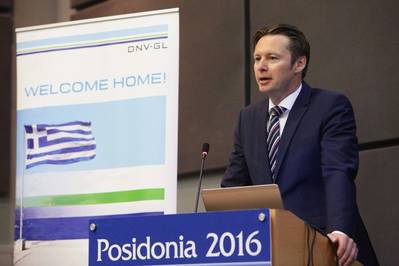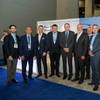DNV GL Presents Modern Classification Solutions at Posidonia
The promise of new modern classification solutions to deliver quality, fulfill customer’s needs, and implement innovative technologies was the key theme for DNV GL at their press conference at the Posidonia trade fair today. Classification society, DNV GL outlined some of the steps it is taking to respond to the tough maritime market and the impact of new technologies on both its customers and on the classification business as a whole.
DNV GL’s Group President and CEO Remi Eriksen spoke about the importance of innovation and the coming digital transformation of the shipping industry. “Our experts drive more joint industry projects than any other organization, and we share the new insight gained with the industry and authorities,” he said. “DNV GL wants to be a driving partner in the digital development by contributing with the combination of our vast global industry experience as a leading class society with our digital and software capabilities. We will also use half of our investments in innovations to be targeted to help us – and our customers – in making the digital transformation.”
Knut Ørbeck-Nilssen, CEO of DNV GL – Maritime, set out some examples of how DNV GL was working to modernize classification, with innovative class services that would help customers respond to the challenges of today’s tough markets. Core class services were ripe for innovation he said, including the survey of vessels.
DNV GL had been testing the use of drones to conduct surveys inside ship tanks, he said, which had generated a lot of interest from the industry. DNV GL had now become the first classification society to complete production surveys using a drone to assist surveyors, he announced. The survey took place on the MV Apollo, a chemical tanker owned by Carl Büttner Shipmanagement GmbH in Bremerhaven, Germany.
“The success of the first drone production survey shows how our investment in developing modern class solutions to benefit our customers is paying off,” he explained. “Over the next few years we will continue to work on expanding the ways drones can be used and the number of stations where we can offer this service. This is a very promising beginning and one that is already showing a significant benefit in terms of time and costs saved.” At the core of DNV GL’s push to modernize its class services was the development of the new rule set, which entered into force this year, Knut Ørbeck-Nilssen said. One of the key goals of the development process was to make sure the rules are future ready by taking future technologies into account – including notations to enable alternative fuel use. “This is why we are especially proud to announce the classification contract signing for Stena Line’s new RoPax ferries to be constructed in Shanghai at the AVIC Shipyard. These are the first RoPAx vessels built to the new rules,” said Ørbeck-Nilssen.
“That a quality focused and innovative owner like Stena Line has chosen to construct these vessels to the new DNV GL rule set clearly shows that our customers are responding to the possibilities created by the rules,” he added. The RoPax ferries will be “gas ready”, prepared to be fuelled by either methanol or LNG. The initial order is for four ferries, with an option for four more, with delivery planned in 2019 and 2020.
“At DNV GL, using data in a smarter way has become one of our core strategies for the future,” said Knut Ørbeck-Nilssen, as he examined some of the new ways DNV GL was helping its customers to more simply, transparently and quickly manage their classification needs and utilize the data from their vessels and fleet.
“To reap the benefits from the increased amount of data that is available today, we need to be able to gather it, access it easily and keep it secure. This is why we have joined with NYK Line and MAN Diesel & Turbo in a joint development project, to establish a prototype data centre,” he explained. The aim of the new project is to develop a working prototype of a scalable common maritime data centre, where operational data is collected and made available to all of the relevant stakeholders.
“Many of our customers are at home in Greece and so are we – which is why we are making Greece our ‘third home market’,” said Ioannis Chiotopoulos, Regional Manager for the East Mediterranean, Black and Caspian Sea in his presentation. This relationship went back more than 100 years, he noted, and was very important to DNV GL’s future. As a result, DNV GL had put in place a series of measures to enhance services to the Greek shipping community, boost response times and strengthen the responsibilities and capabilities in the region, he explained. Segment directors for bulk and tankers were also now based in Piraeus, he said, as was a DATE (Direct Access to Technical Experts) service centre. The approval centre would now perform all fleet in service approvals locally – allowing Greek customers to conduct businesses more easily and directly in Piraeus.
Chiotopolous also examined some of the research and development projects being driven from the Piraeus office. A new project, LPGreen, sees DNV GL working with Hyundai Heavy Industries (HHI), Wärtsilä, MAN Diesel & Turbo and Consolidated Marine Management (CMM) on a design concept for a state-of-the-art next generation LPG carrier. The second phase of the award winning LNGreen concept design will focus on further optimization of the containment system, its general systems configurations and options for increasing its operational efficiency and cost-effectiveness. The final results of the LNGreen II project by DNV GL, GTT, GasLog and Hyundai Heavy Industries will be presented at Gastech in 2017.











